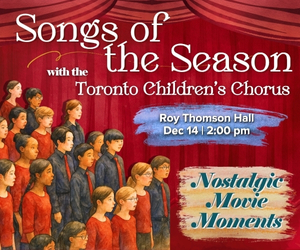 The undoubted highlight of the fall season is the world premiere of “The Nightingale and Other Short Fables,” directed by the renowned Robert Lepage. This is only his second project for the Canadian Opera Company – after his Bluebeard’s Castle/Erwartung of 1993, which caused the COC to be invited to festivals all over the world. Lepage has more of a hand in this production than the earlier one, since he also chose the various vocal and instrumental pieces by Igor Stravinsky that make up the evening’s programme, along with the two short operas The Nightingale (Le Rossignol) and Renard.
The undoubted highlight of the fall season is the world premiere of “The Nightingale and Other Short Fables,” directed by the renowned Robert Lepage. This is only his second project for the Canadian Opera Company – after his Bluebeard’s Castle/Erwartung of 1993, which caused the COC to be invited to festivals all over the world. Lepage has more of a hand in this production than the earlier one, since he also chose the various vocal and instrumental pieces by Igor Stravinsky that make up the evening’s programme, along with the two short operas The Nightingale (Le Rossignol) and Renard.
For The Nightingale and Other Short Fables, Robert Lepage draws on ancient and contemporary storytelling traditions, incorporating singers, acrobats and Asian shadow puppetry geared to appeal to audience members of all ages. A co-production with the Festival d’Aix- en-Provence and l’Opéra national de Lyon, in collaboration with Lepage’s Ex Machina company, this is the production’s only North American engagement. It runs October 17, 20, 22, 24, 30, and November 1, 4 and 5, and is sung in Russian with English surtitles.
The programme begins with a selection of short, non-operatic pieces: the jazzy octet Ragtime (1916), a set of four nonsense songs called Pribaoutki (1914), the four lullabies that comprise the The Cat’s Cradle Songs (1917), Two Poems of Constantin Balmont (1911), Four Russian Peasant Songs (1917) and Three Pieces for Solo Clarinet (1919). The songs introduce the theme of animals central to the two operas presented after the intermission.
Both The Nightingale and Renard were unconventional works in their own time. The Nightingale had its first performance in 1914 at the Paris Opera in a production by Sergei Diaghilev with the singers in the pit and their roles mimed and danced on stage. The next year the Princesse Edmond de Polignac commissioned Stravinsky to write a piece that could be played in her salon. Stravinsky envisioned Renard as a new form of theatre in which acrobatic dance would be connected with singing while declamation commented on the action. As it happened, the premiere of Renard never took place in the salon, but as part of a double-bill with Mavra in 1922 by the Ballets Russes, again at the Paris Opera. As with The Nightingale, the singers were part of the orchestra, while their roles were danced on stage.
In The Nightingale and Other Short Fables, Lepage takes Stravinsky’s innovations several steps further. The orchestra pit will be filled with water to become a pool where the singers perform and manipulate puppets designed by award-winning American puppet designer Michael Curry. The COC Orchestra, under the baton of Jonathan Darlington, performs on stage. The set is designed by Canadian Carl Fillion, who has worked with Lepage on many projects, including Lepage’s upcoming Ring Cycle with the Metropolitan Opera. The lighting designer, Canadian Étienne Boucher, is also part of Lepage’s Ring Cycle team. The Chinese-inspired costumes are by Mara Gottler, resident costume designer with Vancouver’s Bard on the Beach Shakespeare Festival. Lepage’s notion, as explained in several video interviews available through the COC website (www.coc.ca), is to have the course of the action recapitulate the development of puppetry, from the simplest hand shadows to larger two-dimensional variations, and finally to the three-dimensional complexities of Vietnamese water puppetry.
 Renard was last seen in Toronto in an imaginative COC Ensemble production directed by Tom Diamond. The story is based on Aleksandr Afanasyev’s popular compilation, Russian Folk Tales, and follows the Fox’s attempts to outsmart the Cock, who luckily is rescued by the Cat and the Ram. The cast includes Ensemble tenor Adam Luther and baritone Peter Barrett, who were both in Diamond’s production, tenor Lothar Odinius and bass Robert Pomakov. The cast is joined by five acrobats/puppeteers.
Renard was last seen in Toronto in an imaginative COC Ensemble production directed by Tom Diamond. The story is based on Aleksandr Afanasyev’s popular compilation, Russian Folk Tales, and follows the Fox’s attempts to outsmart the Cock, who luckily is rescued by the Cat and the Ram. The cast includes Ensemble tenor Adam Luther and baritone Peter Barrett, who were both in Diamond’s production, tenor Lothar Odinius and bass Robert Pomakov. The cast is joined by five acrobats/puppeteers.
The Nightingale, based on a tale by Hans Christian Andersen, is narrated by a Fisherman (Odinius), who tells of an Emperor (bass Ilya Bannik), who longs to hear the song of the Nightingale (coloratura soprano Olga Peretyatko) at court. The bird appears, but when Japanese emissaries unveil a mechanical nightingale at court, the real bird flies away and the furious Emperor banishes it from his realm. Later, when the Emperor is ill and confronted by Death (contralto Maria Radner), the Nightingale contravenes the edict and returns to save the Emperor in an unexpected and moving way. Tickets are available online at www.coc.ca or by calling 416-363-8231.
Christopher Hoile is a Toronto-based writer on opera. He can be contacted at: opera@thewholenote.com.



